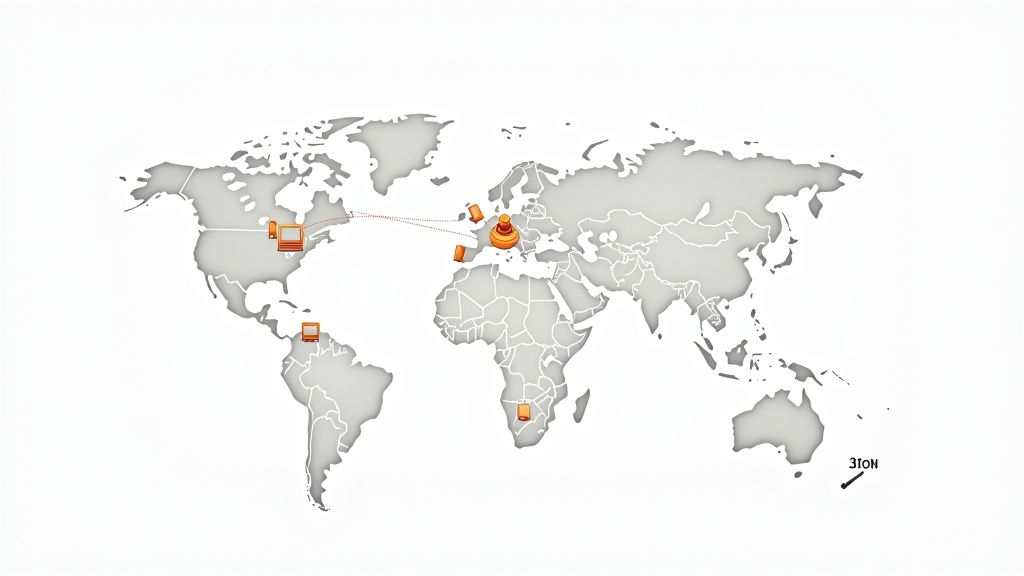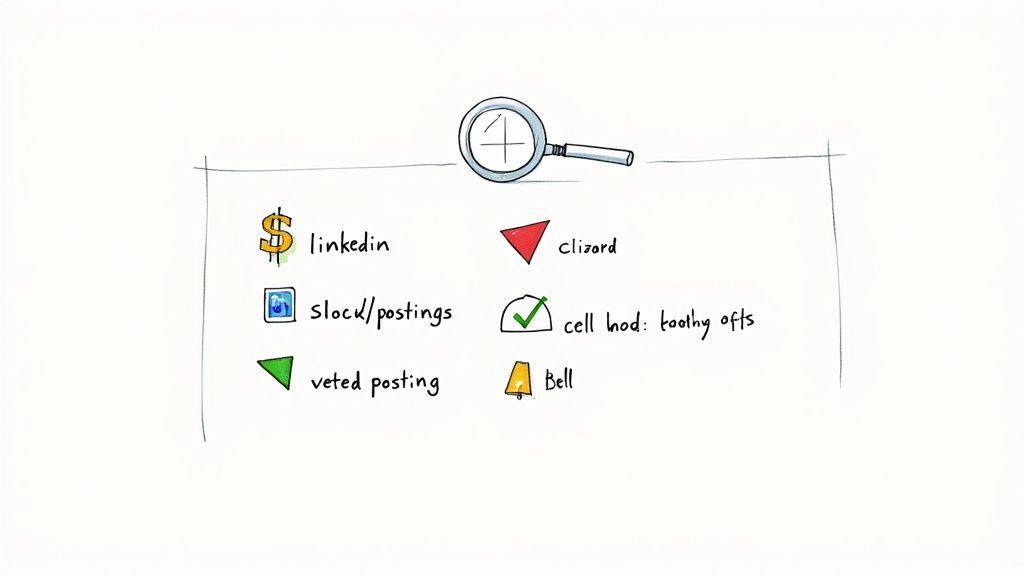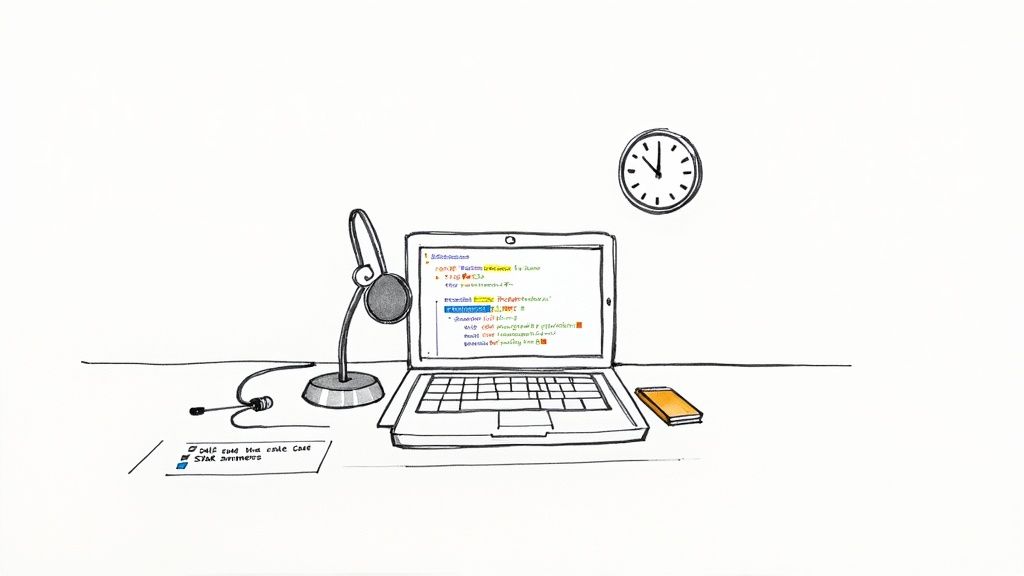Land Remote Software Engineering Internships
Max
The whole internship landscape has been turned on its head. Remote software engineering internships aren’t some niche alternative anymore; they’re a mainstream path for launching a career in tech. It’s a huge shift, offering flexibility and access to top companies, no matter where you live.
This change means aspiring developers can get critical, hands-on experience from pretty much anywhere in the world.
The New Landscape of Tech Internships Is Remote
Forget the old days of fetching coffee and being stuck in a cubicle. The modern tech internship has broken free from geography, creating a completely new set of rules and opportunities. This isn’t just a temporary fad, either—it’s a fundamental change in how the industry finds and grows new talent.
Now, companies can tap into a global talent pool, which means you have access to roles that used to be locked away in hubs like Silicon Valley or New York City.
This guide is your field-tested playbook for navigating this new reality. We’re going to cut through the noise and give you a clear roadmap for success, covering everything you actually need to know:
- Finding Hidden Gems: How to discover legit, high-quality remote internships before everyone else piles on.
- Building a Standout Application: Crafting a resume, GitHub profile, and portfolio that screams “I’m ready for a remote role.”
- Acing Remote Interviews: Mastering the virtual technical and behavioral interviews to really showcase your skills and personality.
- Making an Impact: How to contribute from day one and turn that internship into a full-time offer.
Why Remote Is the New Standard
The move to remote isn’t just about convenience; it’s a smart, strategic decision for a lot of companies, and the data backs this up. Remote software engineering internships have exploded in popularity, right alongside the trend for the broader tech workforce.
Recent developer surveys show that 32% of all software engineers worldwide are now remote. That number jumps to 45% in the United States. You’re not just seeing a trend; you’re seeing the new normal take shape.
This shift has deep roots. To really get a handle on the current job market, it helps to look at the bigger picture—the evolution of software development. What used to be a very centralized, in-office job has become more and more distributed, all thanks to better collaboration tools and cloud infrastructure.
Seizing the Opportunity
To meet this demand, specialized platforms have popped up to connect talent with these remote-first companies, making the whole search process way more efficient. Job boards like Remote First Jobs, for example, focus only on verified remote positions.

This screenshot shows just how simple it is to filter for exactly what you want, like a software engineering role, so you only see relevant, quality listings. Using targeted tools like this helps you dodge the spam and low-ball offers you find on generic job sites. You can focus your energy where it actually counts, and this guide will show you exactly how to do it.
How to Find and Vet Legitimate Remote Internships

If you’ve ever typed “remote SWE intern” into a search bar, you know it can feel like shouting into the void. The big, generic job boards are often a mess of outdated listings, descriptions that tell you nothing, and, unfortunately, a few outright scams.
To land a great remote software engineering internship, you need to be more strategic than that. It’s about focusing your energy where real opportunities live and learning to spot the difference between a career-building experience and a total waste of time.
Go Beyond Generic Job Boards
Stop the endless scrolling on massive job sites. Your first move should be to pivot to specialized platforms that actually curate remote-first roles. Boards built specifically for remote work, like Remote First Jobs, do the heavy lifting for you by vetting companies and ensuring the listings are fresh.
This is where you need to get friendly with the filters. Don’t just search by a title. Get specific and filter by:
- Skills: Zero in on roles that match your tech stack, whether it’s Python, React, or AWS.
- Time Zone: Find an internship that actually works with your schedule.
- Company Size: Are you looking for the scrappy energy of a startup or the structure of a larger corporation? Filter for it.
Set up alerts on these sites. That way, new and relevant remote software engineering internships land in your inbox the moment they’re posted, giving you a serious head start.
Turn LinkedIn Into an Active Opportunity Engine
Your LinkedIn profile should be more than a static resume—it needs to be a tool that works for you. Start by optimizing your headline and summary with keywords that recruiters are searching for, like “Aspiring Software Engineer” and “Seeking Remote Internship.”
But don’t stop there. Actively engage with content from engineers and recruiters at companies you’d love to work for. A thoughtful comment on a post about a new product launch or a technical breakdown can get you on their radar in a way an application alone never will.
Pro Tip: When you connect with an engineering manager or university recruiter, skip the generic request. Send a personalized note. Mention a specific project they worked on that impressed you or why you’re genuinely excited about their company’s mission. That tiny bit of effort makes a world of difference.
Uncover Opportunities in Niche Communities
Honestly, some of the best remote software engineering internships never even hit a public job board. They get shared first within tight-knit developer communities on platforms like Discord and Slack.
Find and join groups dedicated to your programming language (like a Python developers Discord) or your specific interests (maybe a machine learning Slack channel). Don’t just lurk—participate. Share your projects, ask smart questions, and keep an eye on the #jobs or #opportunities channels. This is where you find the hidden gems.
How to Spot Internship Scams and Red Flags
The remote world has, unfortunately, attracted its share of scams. Phishing attempts dressed up as job offers are on the rise, so you have to stay sharp. For a deeper dive, check out our guide on finding legitimate work-from-home jobs, which breaks down common tactics.
Beyond the obvious fraud, some “internships” just aren’t worth your time. Here are the big red flags to watch for:
- Unpaid “Exposure” Roles: Let’s be clear: a real software engineering internship pays you for your work. Unpaid roles are often unstructured, exploitative, and a sign the company doesn’t value its interns.
- Vague Responsibilities: If the job description is packed with buzzwords but gives you zero concrete details about what you’ll actually be building, be wary. You need to know what you’ll be doing.
- Application Fees: You should never have to pay to apply for an internship. Ever.
- No Online Presence: A sparse website, no employee profiles on LinkedIn, or a complete lack of a public footprint is a massive red flag.
Identifying Green Flags for a Great Experience
On the other hand, fantastic remote software engineering internships have a few things in common. Keep an eye out for these green flags, because they signal a company that truly invests in its interns’ success.
| Green Flag | Why It Matters |
|---|---|
| Structured Mentorship Program | This shows they’re serious about your growth. You’ll have a go-to person for guidance instead of being left to fend for yourself. |
| Clear Project Ownership | You want to work on a real project with clear goals, not just get stuck with random bug fixes no one else wants to do. |
| Inclusion in Team Rituals | Getting invited to daily stand-ups, sprint planning, and virtual team events means they see you as part of the team. |
| Access to Tools and Resources | The company should provide you with the software, equipment, and documentation you need to succeed from day one. |
An internship that ticks these boxes means you’ll do more than just write code. You’ll learn how a professional remote engineering team actually collaborates, communicates, and ships products.
Building Your Remote-Ready Application Package

When you’re going for a remote software engineering internship, your application is everything. There’s no campus career fair or in-person handshake to make an impression. It all comes down to your resume, your GitHub, and your portfolio. These aren’t just separate files; they’re a single, cohesive story that has to convince a recruiter you’re ready to contribute from anywhere in the world.
The theme of that story? Proving you can thrive in a high-autonomy, asynchronous workplace. Hiring managers need more than just a coder. They need someone who communicates clearly, documents their work, and can manage their own time without constant supervision.
Crafting a Remote-Focused Resume
Your resume is the gatekeeper. First, it has to get past the bots. Many companies use an Applicant Tracking System (ATS) to filter candidates, so your formatting and keywords are make-or-break. Using ATS-friendly resume templates for tech professionals is a smart move to ensure you even make it to a human reviewer.
But beating the bots is just step one. Your resume needs to scream “remote-ready” to the person reading it. This means going beyond a simple list of your technical skills. For every project you list, think about the how:
- How did you communicate? Mention tools like Slack, Microsoft Teams, or Discord.
- How did you manage tasks? Note your experience with project management tools like Trello, Jira, or Asana.
- How did you collaborate on code? Emphasize your workflow with Git, GitHub, pull requests, and code reviews.
So instead of a generic bullet point like, “Developed a new feature,” you level it up. Try something like: “Developed a user authentication feature, managing tasks on a Trello board and collaborating with a partner via GitHub pull requests and asynchronous Slack updates.”
That one small change tells a recruiter you already understand the remote workflow. For more tips on this, our deep dive on building a resume for remote jobs has you covered.
Your GitHub Is Your Remote Workspace
For any developer, a GitHub profile speaks louder than a resume ever could. A common rookie mistake is obsessing over the “green squares” from daily commits. Recruiters don’t care about the quantity of your commits; they care about the quality and clarity of your work. Your real goal should be to feature 2-3 highly polished projects that give a real window into how you operate.
A well-documented project on GitHub is the single best way to prove you can work independently. It shows a recruiter that you can think through a problem, build a solution, and explain it clearly to someone else—all core skills for a remote engineer.
Every single one of these spotlight projects needs a pristine README.md file. This is absolutely non-negotiable. A great README is direct proof of your documentation and communication skills, which are gold in a remote team.
A stellar project README.md should always include:
- A Clear Project Title and Description: What is it and what problem does it solve? Keep it to a sentence or two.
- Live Demo Link: Make it easy for them to see your work in action. Host it on a platform like Vercel, Netlify, or Heroku and link it prominently.
- Installation and Usage Instructions: Write clear, step-by-step instructions so another dev can get your project running locally. This shows you can write for a technical audience.
- Tech Stack: List the key languages, frameworks, and tools you used.
A Real-World Example in Action
Let’s look at a practical example. An applicant, Sarah, wanted to stand out for remote software engineering internships. She had built a solid full-stack e-commerce app using React and Node.js, but her initial GitHub presentation was pretty generic.
Here’s how she transformed her project to scream “remote-ready”:
- She documented her process: In her
README, Sarah added a “Development Process” section. In it, she linked to the public Trello board she used for the project, showing exactly how she broke down the work into user stories, tasks, and sprints. - She showcased collaboration: Sarah had worked with a classmate on one feature using a standard feature-branching workflow on Git. She highlighted this by linking to specific pull requests where they had conducted code reviews and left comments for each other.
- She wrote a concise project summary: Right at the top of her README, she added a GIF of the app in action and a simple one-sentence summary: “A full-stack e-commerce site for a fictional bookstore, built with the MERN stack and deployed on Vercel.”
Suddenly, when a recruiter landed on her GitHub, they didn’t just see code. They saw a structured, well-documented project managed with the same tools their own remote team used every day. That’s the kind of concrete evidence that proves you can deliver high-quality work without someone looking over your shoulder.
Application Component Checklist for Remote Roles
To bring it all together, here’s a quick checklist to make sure your application package is optimized to catch a remote recruiter’s eye.
| Component | Key Optimization for Remote | Example Action |
|---|---|---|
| Resume | Explicitly mention collaboration tools & processes. | Change “Built feature” to “Collaborated on feature via GitHub PRs & Slack.” |
| GitHub Profile | Curate 2-3 high-quality, well-documented projects. | Pin your top projects and ensure each has a detailed README.md file. |
| Project READMEs | Include a live demo link and setup instructions. | Add a “Live Demo” section with a link to a Vercel or Netlify deployment. |
| Portfolio Site | Tell a story about why you built each project. | Write a short case study for each project explaining the problem and your solution. |
Following this checklist ensures you’re not just showing what you can build, but how you build—which is exactly what remote hiring managers need to see.
Acing Your Remote Technical and Behavioral Interviews

The interview process for a remote software engineering internship is a different beast entirely. It’s not just about solving a problem on a whiteboard; it’s about proving you can think, code, and collaborate effectively through a screen.
How you articulate your thought process while navigating a shared coding editor is just as important as the final solution. This is your chance to show the hiring manager you have the problem-solving chops and the communication skills to thrive in the exact environment where you’ll be working.
Creating a Bulletproof Remote Setup
Let’s be blunt: technical glitches are the fastest way to derail an otherwise great interview. Don’t let a spotty connection or a distracting background undermine all your hard work. Before you hop on that call, run through this checklist to create a professional, distraction-free environment.
- Test Your Tech: The day before, do a full dry run. Test your camera, microphone, and internet connection using the exact video conferencing tool the company uses, whether it’s Google Meet, Zoom, or Microsoft Teams.
- Find a Quiet Space: Make sure you won’t be interrupted by roommates, family, or pets. Finding a quiet spot shows you respect the interviewer’s time.
- Optimize Your Background: A clean, neutral background is always your best bet. A tidy bookshelf or a blank wall works perfectly. If your space is cluttered, use a simple, professional-looking virtual background as a last resort.
- Get Your Lighting Right: Position a light source in front of you, not behind. Good lighting makes a huge difference in how you appear on camera, helping you look engaged and professional.
Nailing these simple steps ensures that the focus remains entirely on you and your skills—not on your Wi-Fi.
Mastering the Remote Technical Screen
Think of the remote technical interview as a performance. The interviewer isn’t just watching your code appear; they’re listening to your narration. This is where you have to master the art of “thinking out loud.”
Platforms like CoderPad or HackerRank are pretty standard for these interviews. Your goal is to make it easy for the interviewer to follow your logic from start to finish.
Before you type a single line of code, verbally outline your plan. You might say something like, “Okay, my initial thought is to solve this using a hash map to track frequencies. This should give us an O(n) time complexity. I’ll start by initializing the map and then iterating through the input array.”
This simple act turns a silent coding session into a collaborative problem-solving exercise. It shows you can communicate technical concepts clearly—a non-negotiable skill for any remote role.
The biggest mistake candidates make is jumping straight into coding without explaining their approach. Always clarify the problem and state your intended strategy first. It shows you have a methodical process and gets you and the interviewer on the same page from the get-go.
Answering Remote-Specific Behavioral Questions
Behavioral interviews for remote roles are designed to find out one thing: can you be trusted to get work done without someone looking over your shoulder? The interviewer needs to know if you have the self-discipline and communication habits to succeed without in-person supervision.
The STAR method (Situation, Task, Action, Result) is your secret weapon here. It provides a simple framework for structuring your answers with concrete evidence, not just vague claims.
Get ready for some common remote-focused prompts:
- “Tell me about a time you resolved a conflict over Slack or email.”
- “How do you ensure you stay on task without direct supervision?”
- “Describe a project where you had to collaborate with others in different time zones.”
For example, if you’re asked about staying on task, you could use the STAR method to describe a specific university project. You might detail the (S)ituation of a complex assignment with a tight deadline, the (T)ask of breaking it down into manageable parts, the (A)ction of using a tool like Trello to track your progress and set daily goals, and the ®esult of delivering the project ahead of schedule.
This approach provides tangible proof of your skills, making your answers far more impactful. If you want more practice, reviewing common software engineer interview questions can help you prepare compelling stories that showcase your remote-readiness.
How to Evaluate Offers and Prepare for a Remote Start
Getting an offer for a remote software engineering internship is a huge win, but now the real work begins. A great opportunity is about so much more than just a big hourly rate; it’s about the whole package—from the mentorship you’ll receive to the perks that actually support your remote setup.
You have to look at the complete picture. The best remote internships are built to help you grow, with clear support systems that fully integrate you into the team, even if you’re miles away.
Deconstructing the Compensation Package
Let’s be real, the first thing most of us look at is the pay. The good news? Compensation for remote software engineering internships is still incredibly competitive, often matching or even beating in-office roles.
In 2025, top tech firms like Citadel, Palantir, and Uber offered remote interns rates anywhere from $46 to $120 per hour. Some fintech companies paid even more. This data, which you can dig into deeper with this list of Big Tech SWE internship salaries, proves that companies aren’t lowballing just because the role is remote.
But don’t stop at the base pay. Look for other financial signals that point to a strong remote culture:
- Home Office Stipend: Is the company offering a one-time payment or a recurring allowance for a good monitor, a comfortable chair, or a mechanical keyboard?
- Tech Provided: Are they shipping you a company laptop and other gear, or are you expected to bring your own device?
- Other Perks: Some companies go the extra mile with stipends for internet service, co-working space passes, or even wellness apps.
These details matter more than you think. A solid home office stipend shows the company is actually invested in setting you up with a productive, ergonomic workspace. And if the pay isn’t quite hitting the mark, don’t be afraid to talk about it. Our guide on how to negotiate a salary offer has some solid, actionable advice for that conversation.
Questions to Ask Before You Sign
Before you say yes, you need to get crystal clear on the expectations. This isn’t about being difficult—it’s about setting yourself up to succeed from day one.
A remote internship thrives on clear communication and well-defined expectations. Asking detailed questions now prevents confusion later and shows the hiring manager that you are proactive and serious about your role.
Hop on a quick call with your future manager or recruiter and get answers to these essential questions:
- Mentorship Structure: Who is my dedicated mentor? How often will we meet, and what does that process actually look like?
- Team Communication: What are the core working hours for the team? What’s the expected response time for messages on Slack or Teams?
- Onboarding Process: What does my first week look like? How will I get my dev environment set up and meet everyone on the team?
- Project Scope: What specific project will I be working on? What are the key things I’ll be expected to deliver by the end of the internship?
Preparing for a Strong Remote Start
Once you’ve accepted the offer, it’s time to shift gears and prep for a smooth start. Those first few weeks are your chance to build relationships and make your presence known.
Your first priority is getting your technical setup sorted. The minute that company laptop arrives, block off time to get your development environment configured. Follow the company’s documentation to the letter, and don’t be shy about asking your mentor for help if you hit a wall.
Just as important is building those social connections. In an office, this stuff happens organically by the coffee machine. Remotely, you have to be intentional. Proactively schedule 15-minute virtual coffee chats with your teammates during your first two weeks. A simple message like, “Hey, I’m the new intern on the team and would love to connect for a quick intro call when you have a free moment!” goes a long way. It helps you build rapport and makes you a visible, integrated member of the team right from the start.
Turning Your Internship Into a Full-Time Remote Offer
Your internship isn’t just about the work; it’s an extended interview for a full-time role. The real goal is to walk away with a return offer. In a remote setup, this means visibility and proactivity are your best friends.
Unlike in an office where your presence is a given, you have to be deliberate about showing your commitment and impact. You can’t rely on casual chats by the coffee machine to build rapport.
A ridiculously simple yet powerful tactic is the “weekly wins” summary. Every Friday, drop your manager a quick, bulleted Slack message. Highlight what you accomplished, what you learned, and any hurdles you cleared. This tiny habit makes your contributions impossible to overlook.
Making Your Impact Visible
Beyond status updates, get comfortable with sharing your work before it’s “perfect.” Good documentation and asking for feedback early and often are signs of a mature engineer. Don’t hide away until a deadline; share your work-in-progress and ask for input. It shows you’re collaborative and eager to learn—two traits every remote team desperately wants in a full-time hire.
You also need to network with intention. Set up a few 15-minute virtual coffees with other engineers on your team, and maybe even folks in different departments. Ask them about what they do, their career path, and what they love about the company. These connections build your reputation as someone who is genuinely engaged and curious.
The good news? The odds are in your favor. A recent study found that 80.5% of employers extended full-time job offers to their virtual interns. It’s clear proof that strong remote performance gets noticed and rewarded. You can read more about these positive internship statistics.
At the end of the day, your manager is looking for a sense of ownership. When you consistently show initiative, you’re sending the clearest possible signal that you have the self-direction to thrive without constant oversight. That’s the key to turning your internship into a career.
For more ideas on this, check out our guide on how to be proactive at work.
Frequently Asked Questions
When you’re diving into the world of remote software engineering internships, a few questions always seem to pop up. Let’s tackle some of the most common ones we hear from students and new developers.
Are Remote Internships Less Prestigious Than In-Person Ones?
Not at all. The prestige of an internship has everything to do with the company and the work you’re doing, not where your desk is. Top-tier companies like Google and Meta, along with some of the fastest-growing startups, are running highly competitive remote programs.
In fact, recruiters today see a successful remote internship as a huge green flag. It tells them you’re mature, self-disciplined, and a great communicator—skills that are gold for any full-time role, remote or not.
How Do I Handle Different Time Zones?
This is a big one, and you need to get it sorted out before you sign anything. Many companies will need you to have at least a few overlapping work hours with their core team for meetings and collaboration.
Just ask about it during the interview. Be upfront about where you are and what your typical working hours look like. Any company that has its remote culture figured out will have clear expectations around asynchronous work and team availability.
Here’s a pro tip: Communication is everything. If you’re on the other side of the world from your team, work with your manager to create a solid plan for daily handoffs and updates. It shows you’re thinking ahead and are serious about making it work.
Are International Students Eligible for US-Based Remote Internships?
It really depends. A company’s ability to hire you for a remote software engineering internship is tied to its legal and tax structure. Some can only hire in specific countries or even states where they’re registered as a business.
Always read the job description carefully for location requirements—many will explicitly say “U.S. Only” or “North America Only.” If it’s not clear, it’s completely fine to ask the recruiter about their policy for international candidates early on. Better to know now than after you’ve spent hours on the application.
Ready to find a role that fits your skills and your time zone? Remote First Jobs has thousands of verified remote software engineering internships and full-time jobs from great companies all over the world. Kick off your search and find your next big opportunity at https://remotefirstjobs.com.


